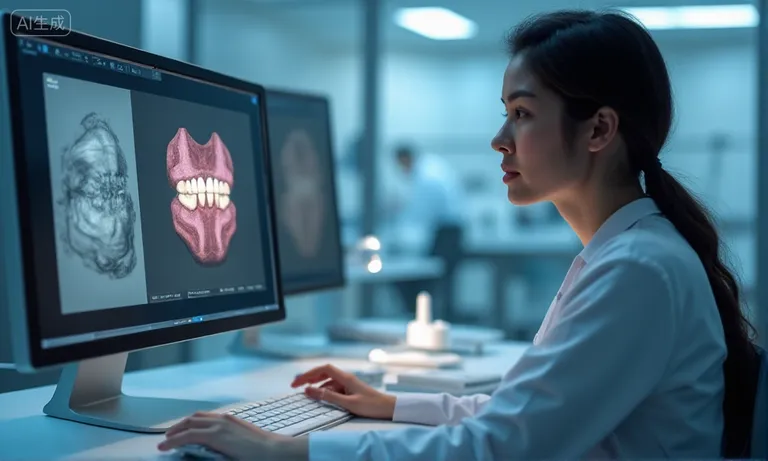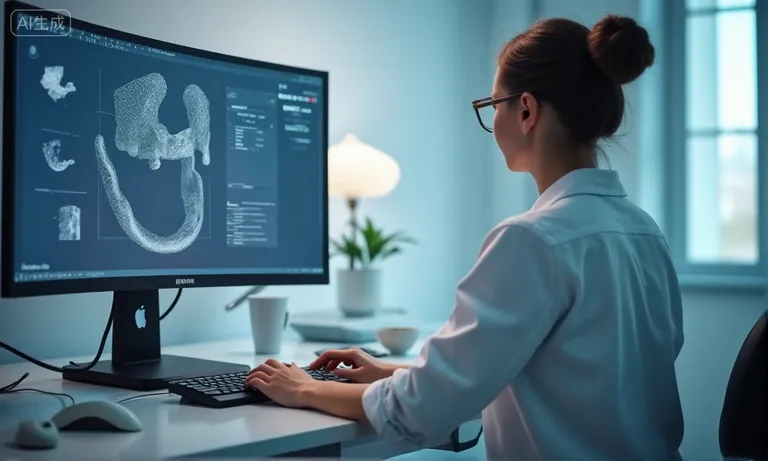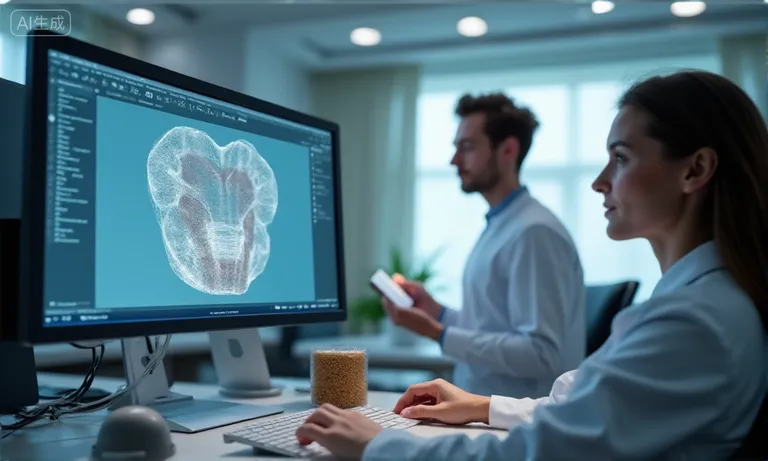3D printing is transforming how dental implant labs approach customization, enabling them to deliver highly individualized restorations without sacrificing efficiency. By combining digital workflows with precise fabrication methods, labs can maintain accuracy in even complex implant cases without extending production timelines.
For procurement teams, several dimensions are especially important to evaluate:
- Precision in customization — restorations that capture fine anatomical detail and maintain consistent fit.
- Workflow efficiency — CAD/CAM integration, STL handling, and automated processes that minimize delays.
- Material flexibility — matching zirconia, cobalt-chrome, or resin to the restoration type and clinical need.
- Complex case capability — digital templates and surgical guides that balance accuracy with speed.
- Reliability signals — documented delivery records and case outcomes that demonstrate consistency and scalability.
By assessing these factors, buyers can identify which dental implant labs are capable of supporting advanced customization while keeping cases on schedule. The result is predictable delivery, higher restorative quality, and stronger confidence in long-term collaboration.
What Makes 3D Printing Effective for Customized Dental Implant Restorations?
3D printing is effective for customized dental implant restorations because it combines patient-specific design, high-precision fit, and the ability to balance esthetics with function in ways that traditional methods cannot match. This makes customization both scalable and clinically reliable.

Dental-Lab-3D-Printing-Customized-Implant
Patient-specific design capabilities in implant prosthetics
The greatest strength of 3D printing is true patient-specific adaptation. A scan can be transformed into a restoration that mirrors the patient’s anatomy, from emergence profile to occlusal surface. Unlike standard milling blocks that often require adjustments, additive design allows freedom to replicate unique contours. This is particularly valuable in implant cases where angulation or bone availability makes every restoration different.
Precision in fit: marginal accuracy and fine anatomical details
Customization means little if fit is compromised. With 3D printing, restorations can achieve marginal accuracy within tens of microns, capturing fine grooves and internal geometries. This precision reduces chairside adjustments and minimizes remake rates. Buyers evaluating labs should look for evidence of calibration protocols and routine accuracy checks, as these ensure that customization translates into predictable clinical performance.
Balancing esthetics and functional requirements in complex restorations
Customization is not only about precision—it is about achieving both esthetic lifelike appearance and durable function. For anterior cases, printing technology can reproduce subtle translucency and natural morphology. For posterior or load-bearing restorations, the design can prioritize occlusal strength without compromising delivery time. Experienced labs know how to tune parameters for case-specific outcomes, balancing artistry and biomechanics.
By combining design flexibility, high accuracy, and adaptability to both functional and esthetic demands, 3D printing allows labs to deliver customized implant restorations that are efficient, predictable, and clinically relevant.
How Does the Digital Workflow Streamline Customized Case Production?
Digital workflows streamline customized implant cases by eliminating manual handoffs, standardizing design steps, and enabling real-time collaboration between clinics and labs. Instead of slowing production, digitization turns personalization into a predictable and scalable process.

Dental-Lab-Digital-Workflow-Implant
CAD/CAM integration and STL file handling across clinics and labs
The foundation of digital customization is smooth CAD/CAM integration. STL files move seamlessly from intraoral scanner to design station, eliminating errors common in traditional impressions. With shared implant libraries and compatible CAD software, labs can prepare designs that match specific components without delay.
- Direct file transfer reduces courier dependency.
- Cross-platform compatibility prevents rework.
- Shared implant libraries ensure accurate restorative planning.
Automated nesting and design libraries for faster customization
Automation reduces repetitive tasks that slow down custom cases.
| Automation Tool | Impact on Speed | Buyer Value |
|---|---|---|
| Automated nesting | Places multiple restorations optimally on build platforms | Shorter prep time, maximized printer use |
| Design libraries | Provides pre-validated templates for crowns, bridges, and abutments | Faster turnaround with consistent quality |
| Workflow scripts | Automates routine steps like margin marking | Minimizes technician bottlenecks |
Labs using automation deliver custom restorations with less manual setup, freeing technicians to focus on quality checks.
Real-time collaboration and approval to avoid workflow bottlenecks
The digital workflow also enables immediate design review and approval. Instead of waiting days for physical models, clinicians can approve or adjust designs online within hours. This shortens feedback cycles, especially in multi-unit or esthetic-sensitive cases. When both clinic and lab teams see the same design simultaneously, misunderstandings drop and turnaround becomes more predictable.
Digital workflows make customization not a burden but an accelerator. For procurement teams, a lab’s ability to integrate CAD/CAM, leverage automation, and support real-time collaboration is a strong signal of its readiness to handle personalized implant cases efficiently.
What Role Do Materials and Printing Methods Play in Achieving Efficient Customization?
Materials and printing methods directly determine how efficiently a customized implant restoration can be produced while maintaining accuracy and esthetics. Choosing the right material-printer combination ensures that customization does not compromise delivery timelines.
Comparing zirconia, cobalt-chrome, and resin for implant restorations
Each material carries distinct implications for speed, strength, and esthetics:
| Material | Efficiency Profile | Advantages | Considerations |
|---|---|---|---|
| Zirconia | Moderate turnaround | Strong, esthetic, biocompatible | Requires sintering, adds processing hours |
| Cobalt-chrome (CoCr) | Longer turnaround | High strength for frameworks | Additional finishing and polishing time |
| Resin | Fastest turnaround | Quick prototypes, surgical guides | Limited long-term durability |
Labs often balance these trade-offs by aligning the material with the clinical indication.
Matching restoration type with the right 3D printing method
Efficiency also depends on aligning restoration type with technology:
- Resin printers (DLP/SLA): ideal for surgical guides and provisional crowns.
- Milled zirconia from printed designs: best for long-term esthetic crowns and bridges.
- Metal printing (SLM for CoCr): suited for frameworks and bars where mechanical load is high.
By matching case type with the correct process, labs prevent unnecessary delays and ensure predictable turnaround.
How material properties influence design freedom and turnaround balance
Material properties shape not only esthetics but also workflow timing. Zirconia’s sintering cycle can extend delivery by 8–10 hours, but it provides unmatched longevity. Resin prints allow same-day prototypes yet may require remakes if used beyond their intended indication. CoCr frameworks demand extensive finishing but provide stability for complex cases. Buyers should view these choices not as trade-offs but as tools for balancing customization with efficiency.
The key to efficient customization lies in strategic material-method pairing. Labs that master this balance deliver restorations that are esthetic, durable, and on schedule—qualities that define a reliable production partner.
How Can Complex Implant Cases Be Customized Without Slowing Down Delivery?
Complex implant cases can still be delivered efficiently when labs use digital planning, workflow adjustments, and guided tools to maintain accuracy without adding unnecessary delays. Customization at scale is possible if every stage of the process is optimized.
Full-arch and multi-unit cases: maintaining accuracy under high complexity
Full-arch bridges and multi-unit frameworks demand more than single-unit crowns. The challenge lies in keeping accuracy across multiple implant positions and occlusal surfaces. Digital workflows help preserve precision by aligning scans, implant libraries, and virtual articulators. This prevents fit issues that traditionally caused remakes, ensuring that even large restorations stay on schedule.
Workflow adjustments that prevent delays in customized restorations
Labs experienced with complex implant work often use specific adjustments to maintain turnaround times:
- Parallelized workflows → multiple technicians handling design, nesting, and finishing in sync.
- Staggered scheduling → overlapping production steps (e.g., printing surgical guides while frameworks are sintering).
- Automated quality checks → software-driven margin detection or fit simulation reduces manual rework.
- Case segmentation → breaking down a full arch into manageable substructures that later merge.
These strategies transform complexity from a bottleneck into a coordinated workflow.
Using surgical guides and digital templates to streamline complex cases
Surgical guides and pre-designed templates reduce chairside unpredictability.
- Design surgical guide from intraoral scans and CBCT data.
- Print guide with biocompatible resin within hours.
- Integrate guide into the restorative design plan, ensuring implants are placed where restorations can be predictably fabricated.
By standardizing implant positioning, surgical guides remove guesswork and minimize downstream redesign, directly saving days of turnaround.
For procurement teams, the message is clear: complexity does not have to equal delay. With digital coordination and guided workflows, labs can manage full-arch or multi-unit cases within predictable timelines, avoiding the inefficiencies of purely manual production.
What Examples Demonstrate the Balance of Customization and Efficiency?
Real-world cases show that customization and efficiency are not opposites—with the right tools and workflows, labs can achieve both simultaneously. Buyers evaluating potential partners should look for these signals in practice.

Dental-Lab-Case-Examples-Implant-Customization
Case example: patient-specific surgical guide delivered without delay
One clinic needed a surgical guide for a single implant in the esthetic zone. The intraoral scan and CBCT were uploaded digitally, the guide was designed and printed in biocompatible resin within 24 hours, and shipped the same day. What would once require a week with physical models was reduced to two days without compromising precision.
Case example: multi-unit implant bridge produced efficiently
- Case complexity: 5-unit implant-supported bridge.
- Workflow strategy: simultaneous nesting of provisional prototypes and framework in the same build.
- Outcome: framework and provisional crown delivered in 6 business days, without additional remake cycles.
- Efficiency factor: parallelized production steps prevented bottlenecks, proving that multi-unit cases do not always equal extended timelines.
Lessons learned: signals of a lab’s ability to balance customization and efficiency
From these cases, procurement teams can extract practical evaluation signals:
- Clear evidence of digital-first workflows (scan-to-design-to-print).
- Ability to parallelize production instead of waiting on sequential tasks.
- Track record of delivering surgical guides and multi-unit cases predictably.
Customization becomes efficient when labs treat digital workflows as accelerators, not add-ons. At Raytops Dental Lab, we have seen first-hand that combining CAD/CAM, material planning, and real-time approvals enables us to deliver personalized solutions at scale without compromising turnaround—something overseas partners must prove consistently to win long-term trust.
Conclusion
Efficient customization in implant dentistry comes from the integration of digital workflows, smart material-method pairing, and guided processes for complex cases. The result is restorations that are both patient-specific and delivered on schedule. For procurement teams, the real measure of a lab is not only how personalized a restoration looks, but whether it arrives predictably without hidden delays. As an overseas dental lab, Raytops Dental Lab works with clinics, DSOs, and distributors to prove that customization and efficiency can go hand in hand—supporting reliable patient care and long-term operational planning.


